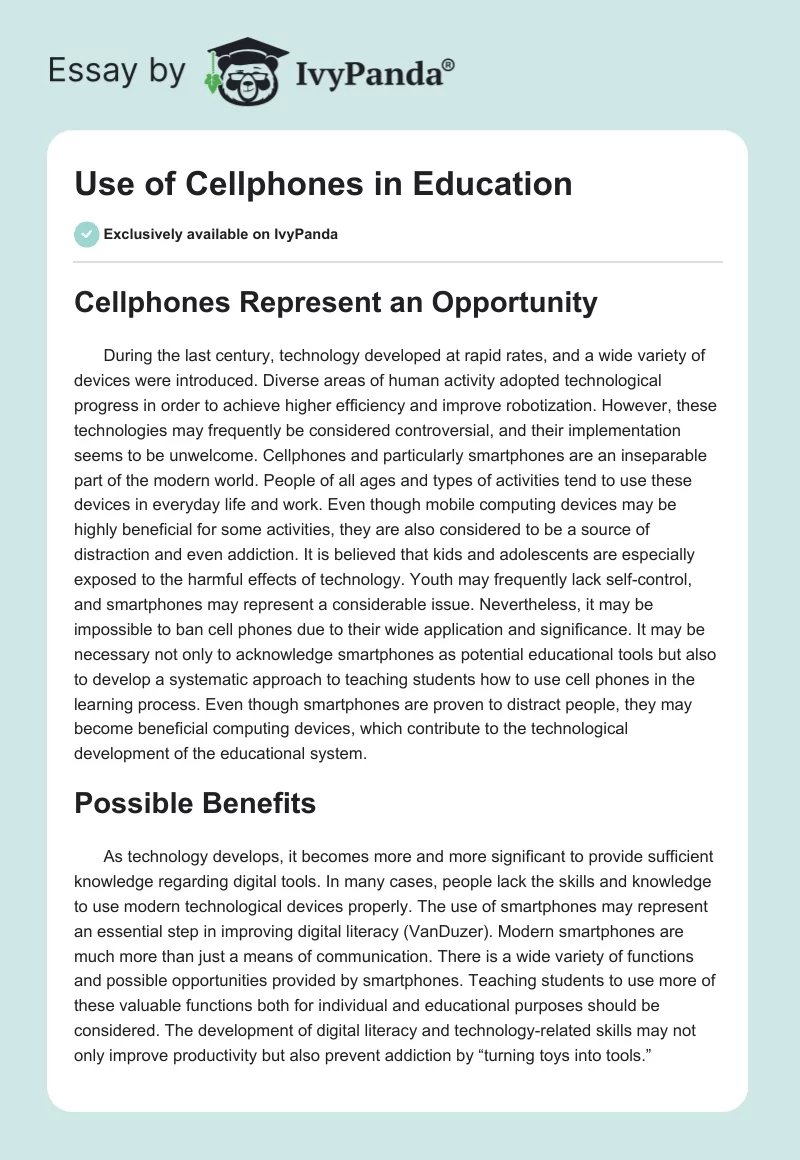Cellphones Represent an Opportunity
During the last century, technology developed at rapid rates, and a wide variety of devices were introduced. Diverse areas of human activity adopted technological progress in order to achieve higher efficiency and improve robotization. However, these technologies may frequently be considered controversial, and their implementation seems to be unwelcome. Cellphones and particularly smartphones are an inseparable part of the modern world. People of all ages and types of activities tend to use these devices in everyday life and work.
Even though mobile computing devices may be highly beneficial for some activities, they are also considered to be a source of distraction and even addiction. It is believed that kids and adolescents are especially exposed to the harmful effects of technology. Youth may frequently lack self-control, and smartphones may represent a considerable issue. Nevertheless, it may be impossible to ban cell phones due to their wide application and significance.
It may be necessary not only to acknowledge smartphones as potential educational tools but also to develop a systematic approach to teaching students how to use cell phones in the learning process. Even though smartphones are proven to distract people, they may become beneficial computing devices, which contribute to the technological development of the educational system.
Possible Benefits
As technology develops, it becomes more and more significant to provide sufficient knowledge regarding digital tools. In many cases, people lack the skills and knowledge to use modern technological devices properly. The use of smartphones may represent an essential step in improving digital literacy (VanDuzer).
Modern smartphones are much more than just a means of communication. There is a wide variety of functions and possible opportunities provided by smartphones. Teaching students to use more of these valuable functions both for individual and educational purposes should be considered. The development of digital literacy and technology-related skills may not only improve productivity but also prevent addiction by “turning toys into tools.”
Another significant benefit of the use of smartphones in education is information. Cell phones may considerably improve the process of finding valuable information and decrease the needed time to mere seconds. With the development of reliable online databases, it may be beneficial to use smartphones as tools to access these data storage easily.
Moreover, cell phones may provide opportunities to use supplementary learning materials and alternative teaching approaches. Smartphones may contribute to the wider usage of video materials and various interactive tasks. Although it may not always be possible to find reliable sources online, with the development of diverse databases, smartphones could provide valuable data.
As already mentioned, communication is one of the major functions of smartphones. Even though there are numerous other uses of these devices, their ability to transfer data remains valuable. Smartphones may be used to maintain communication for educational purposes. There is a wide variety of applications, which may be used to provide better communication not only between students but also between students and the teacher.
Providing handouts in digital format, sending homework online, or conducting short quizzes are some possible uses (Sevillano-García and Vázquez-Cano 113). Furthermore, smartphones may replace heavy textbooks and notes. They may provide a more flexible and convenient approach to storing and accessing data. By developing a proper framework and specific software, it may be possible to turn smartphones into essential educational tools (Norris et al. 39).
Potential Problems
Even though there is a wide list of possible benefits related to the implementation of cell phones in education, there are also some disadvantages. The primary issue regarding smartphones is their additivity and negative impact on attention. Recent research has shown that students tend to perform better if they do not have access to their smartphones during lectures (Mendoza et al. 58).
Smartphones may become a significant source of distraction, and many believe that they should not be allowed at schools. Moreover, constant exposure to smartphones may significantly worsen eyesight. It is proven that long-term use of these modern devices may cause ocular health problems (Kim et al. 274).
Nevertheless, these issues may not outweigh the benefits. In addition, it is also proven that removing smartphones may cause nomophobia, which decreases students’ performance. As cell phones have already become an inseparable part of human lives, it may not be possible to ban them and overcome possible health and attention issues. Moreover, by establishing a studying framework using smartphones, it may be possible to decrease distraction. The transformation of smartphones into educational tools may make them less attractive spare-time “killers” and encourage students to switch to alternative healthier sources of entertainment.
Conclusion
As technology develops, it may be necessary to implement various devices into education. Digital literacy becomes more and more essential in everyday life. Moreover, emerging technologies may significantly contribute to an increase in the efficiency of education. Smartphones provide numerous opportunities, which should not be missed. Even though cell phones also represent some considerable problems related to students’ health and distraction, using cell phones as educational tools may decrease these negative consequences. It is necessary to enforce technologies for the benefit of humanity as it may not be possible to escape progress or reverse it.
References
Kim, Joowon, et al. “Association between Exposure to Smartphones and Ocular Health in Adolescents.” Ophthalmic Epidemiology, vol. 23, no. 4, 2016, pp. 269–276. Web.
Sevillano-García Luisa, and Vázquez-Cano Esteban. “The Impact of Digital Mobile Devices in Higher Education.” Journal of Educational Technology & Society, vol. 18, no. 1, 2015, pp. 106–118. JSTOR. Web.
Mendoza, Jessica S., et al. “The Effect of Cellphones on Attention and Learning: The Influences of Time, Distraction, and Nomophobia.” Computers in Human Behavior, vol. 86, 2018, pp. 52–60. Web.
Norris, Cathleen A., et al. “Inquiry Pedagogy and Smartphones: Enabling a Change in School Culture.” Educational Technology, vol. 53, no. 4, 2013, pp. 33–40. JSTOR. Web.
VanDuzer, Todd. “Learn Why Thousands of Schools Are Embracing the Idea of Cellphones in School.” StudentTutor, 2018. Web.


